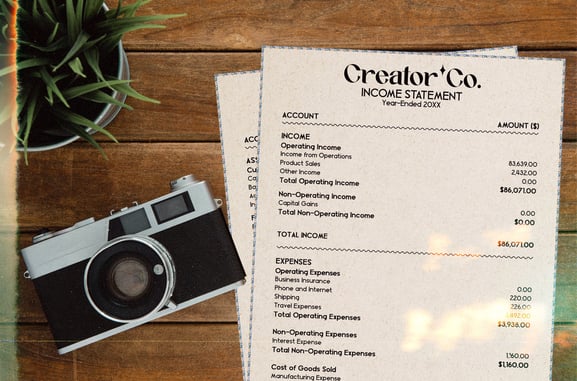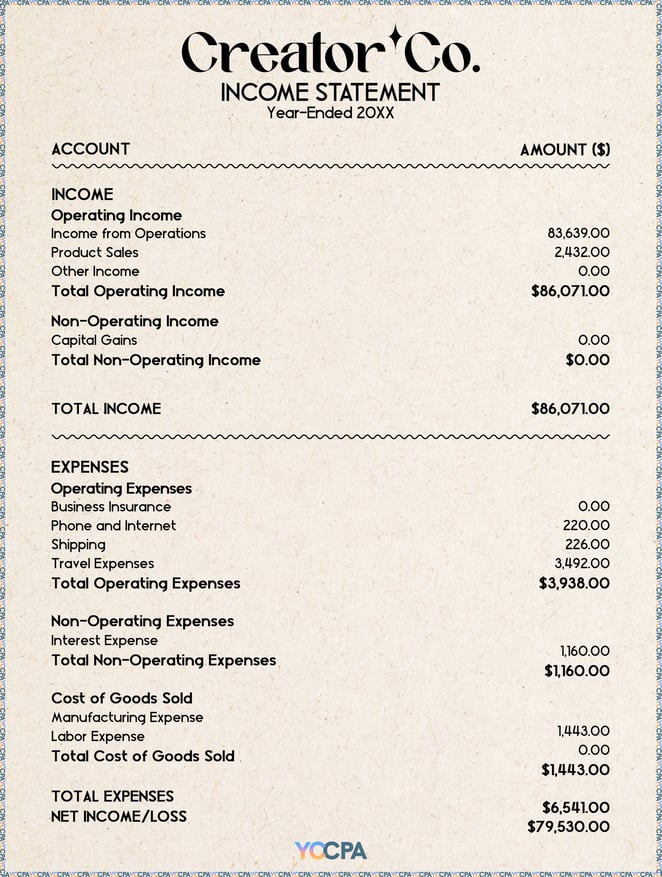
Latest Article: Bitcoin Isn't as Decentralized as You Think. Here's Why.
What is an Income Statement? A Guide for Creators
Master your income statement: an income statement (also known as a profit and loss) is a financial statement that shows a company's income and expenses over a certain period of time. Learn how to create an income statement, see an example of one, and more.
ACCOUNTINGJUMPSTARTBUSINESSINVESTINGBUDGETING
David Kindness, CPA
4/12/2024



What is an Income Statement? A Guide for Creators
Updated on April 11, 2024
Written by David Kindness, CPA
Why you can trust Your Creative CPA
Our content is written, edited, or both by industry experts who are creative entrepreneurs just like you. Learn more.
Are you putting in the work to build a thriving online creative business, but feel lost when it comes to the money side of things? You're not alone! Financial language can be tricky, but understanding a key financial report called an Income Statement can help you master your financials and help your business thrive. This article will explain what an income statement is and how it can help you manage your creative business finances like a pro.
Fast Facts About Income Statements
An income statement, also called a Profit and Loss (P&L), is a financial statement that tracks your business's income and expenses.
Income statements show if you're making a profit (more money coming in than going out) or a loss from your business.
Income statements help you make smart financial decisions for your creative business, such as how much income you have to reinvest in the business each month, quarter, or year.
There are software providers and spreadsheets that you can use to make creating your income statement a breeze.
What is an Income Statement?
Think of an income statement as a financial report card for your creative business. It tells a story about your money in two parts: how much money you make (income) and how much you spend (expenses). This helps you see the "big picture" - are you making a profit (called Net Income) or a loss? Most businesses create income statements annually, and some create them quarterly or even monthly.
What Are Income Statements Used For?
Income statements are like a super useful toolbox for creative entrepreneurs! Here's why they're important:
See your progress: Track how your business is doing over time. Are your sales growing? Are you keeping your spending under control?
Make money moves: Knowing where your money goes helps you decide where to cut back or invest more in your business.
Impress potential partners: If you need a loan or an investor, an income statement shows them how financially healthy your business is.
Tax time prep: Income statements are crucial for filing your taxes accurately. They help identify deductible expenses, which can save you money!
What Information Do You Include On An Income Statement?
An income statement is like a two-sided story: income on one side and expenses on the other. Here's a breakdown:
Income: This includes all the money you earn from your creative business, like sales of your products or services online.
Expenses: This is where you list all the costs associated with running your business. Common expenses include things like materials (paint, fabric, etc.), website fees, marketing costs, and even a portion of your internet bill if you use it for business.
Below is an example of what an income statement looks like and what information is included on it:


Common Expenses Included on Income Statements:
Cost of Goods Sold (COGS): This includes the direct costs of creating your products, like materials and supplies.
Marketing and Advertising: The money you spend to promote your creative work.
Rent and Utilities: Costs associated with your studio or workspace.
Equipment and Software: Expenses related to the tools you use to create your work (computers, cameras, etc.).
Professional Fees: Payments to accountants, lawyers, or other professionals you hire.
Manufacturing and Production Expenses: These are expenses related to the manufacturing or production of products your business sells.
Equipment: Costs of gear you need for your business, like cameras, lenses, computers, etc.
Subscriptions: These are subscriptions for software, music, television, web services, etc related to your business.
Internet and phone: Expenses you pay for internet and phone services for your business should be included on your income statement.
Accounting Software to Create Income Statements Easily
Keeping track of your income and expenses can feel overwhelming, but there are tools to help! Many accounting software programs can help you create and manage your income statement easily. Here are a few popular options:
QuickBooks: a robust, capable, all-purpose accounting and expense tracking software for businesses of all sizes. Additionally, Quickbooks integrates with Turbotax, making tax prep a breeze.
Xero: A capable, cloud-based accounting software designed for small- to medium-sized businesses.
HoneyBook: HoneyBook is a client and project management platform combined with expense tracking and invoice creation, making it an ideal software for businesses of nearly any size.
But don't worry if you're not ready for fancy software yet! You can even create a basic income statement using a spreadsheet program like Google Sheets or Microsoft Excel.
Action Item: Start tracking your income and expenses today, even if it's just on a simple sheet of paper. Starting now will make it much easier to create your income statement later on.
Conclusion
Financial concepts like income statements and balance sheets might seem intimidating at first, but understanding income statements is a valuable skill for any creative entrepreneur. By tracking your income and expenses, you can take charge of your finances, make smarter business decisions, and even save money on taxes.
This article has equipped you with the basics – now you can utilize an income statement to transform your creative business into a financial masterpiece.
Frequently Asked Questions (FAQs)
Can I use spreadsheets to create an income statement for my creative business?
Absolutely! Spreadsheet programs like Microsoft Excel or Google Sheets are great options for creating a basic income statement. You can set up separate columns for income and expenses, categorize your transactions, and use formulas to calculate your net income. There are even free income statement templates you can download online to get you started.
Do I need an accountant to create an income statement?
Not necessarily! For more simple creative businesses, you can create a basic income statement using Excel or Google Sheets. To do this, you'll want to include all income your business receives, as well as all expenses you've spent money on. Once you add up your income and expenses, you can calculate your Net Income, which is a great indicator of how financially healthy your business is.
What if I forget to track some of my income or expenses? Can I estimate them for the income statement?
It's best to try and track your income and expenses as accurately as possible. However, if there are some gaps, you can make estimated entries based on past experience or similar business benchmarks. Just be sure to clearly mark them as estimates in your income statement.
Disclaimer: the information provided in this article is for educational purposes only and does not constitute tax, accounting, investing, legal, or financial advice. The information in this article does not take into account your unique financial or business situation or goals, and YCCPA cannot be responsible for reader's financial decision-making. YCCPA's goal is to educate and support you on your creative business journey.
Written by David Kindness, CPA
David is a CPA (Certified Public Accountant) and professional photographer, videographer, and designer based in San Diego, California. Learn more.




supported by ads
Your Creative CPA is supported by the ads you see in our articles and guides.
These ads allow us to help creatives like you.

financial wisdom for creatives, by creatives
Created by David Kindness
Copyright 2025 Terms






